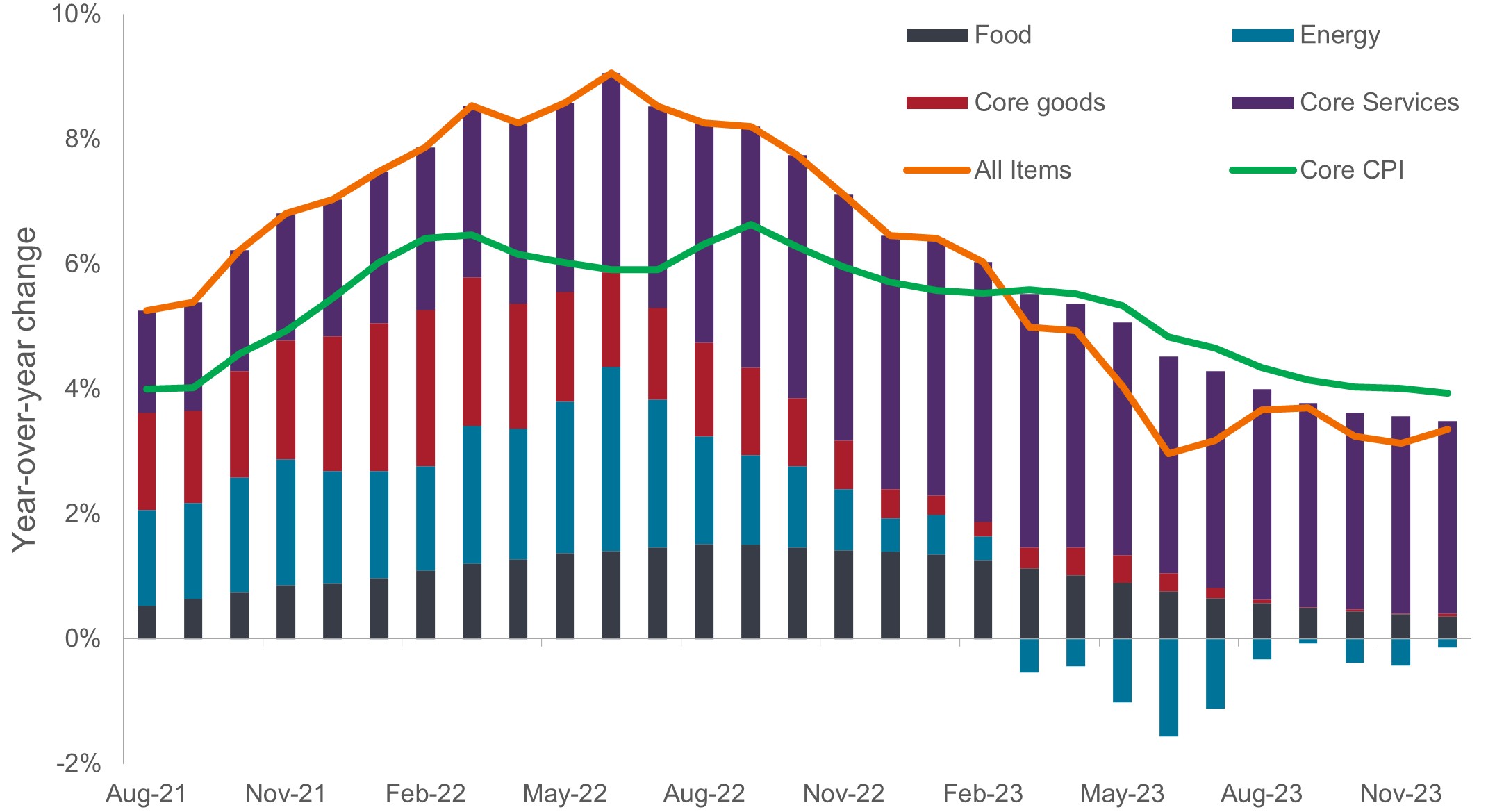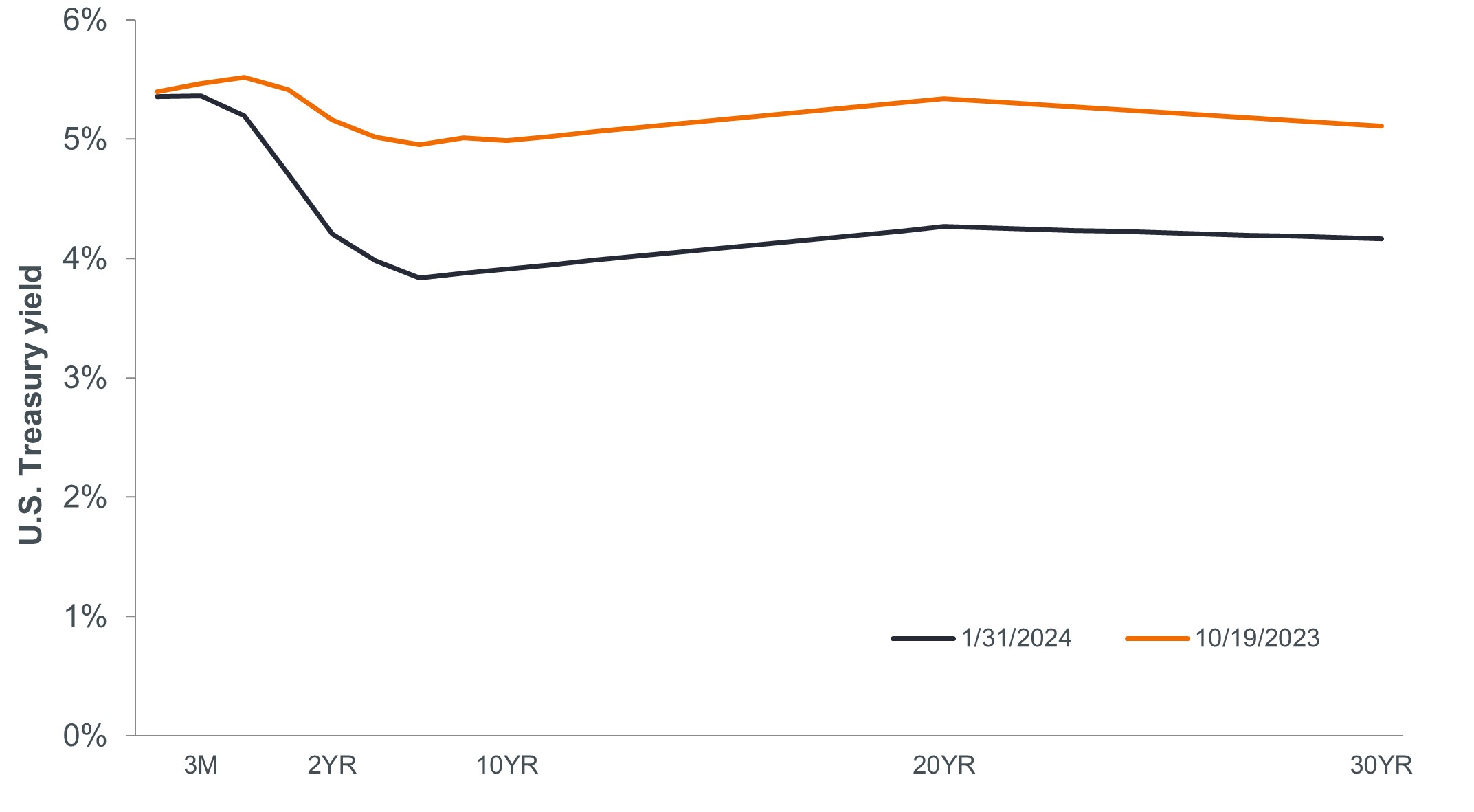Not so fast: The Fed exercises a circumspect approach

Key takeaways:
- In reducing expectations for the timing and number of rate cuts, the Fed reminded the market that it remains focused on ensuring inflation returns to its 2.0% target.
- With economic growth proving resilient and inflation decelerating, the Fed has the luxury to slowly return its policy rate to a neutral stance that balances the risks of its dual mandate.
- The broad-based fixed income rally has created opportunities for investors to differentiate between segments that accurately reflect their prospects and those where mispricing may exist.
In the Federal Reserve’s (Fed) January meeting, Chairman Jerome Powell was charged with the task of explaining how to reconcile the U.S. central bank’s December pivot with a still-resilient domestic economy. With the Fed’s decision to keep rates steady never in doubt, the key takeaway from the meeting was bound to be how this messaging would differ from its December statement. And the central bank did indeed affirm that it would need to gain “greater confidence that inflation is moving sustainably toward 2.0.%” before it could embark on rate reductions. We view this insertion as a reality check for markets that had not only welcomed the Fed’s December pivot but doubled down by predicting up to six 25 basis-point (bps) reductions in 2024.
In forecasting 150 bps of cuts for this year, we don’t think the market fully appreciated the starting point. At 5.5%, the upper bound of the Fed’s target is – at least by recent historical standards – exceptionally restrictive. Such levels were justified given the post-pandemic surge in inflation. Within this context, we did not interpret the Fed’s December statement as overtly dovish, driven by economic data flashing red (they are not). Instead, we viewed the possibility of three cuts in 2024 as an incremental move toward a neutral stance – a tactic afforded by a resilient economy and inflation continuing its downward path.
Balancing the mandate
Absent a crisis, the Fed is an institution that prefers to gauge economic conditions and implement policy methodically. We believe this is precisely what’s in store for 2024. Perhaps the biggest surprise of this cycle is the realization that a 5.5% overnight rate is not as restrictive as many had feared. Economic data bear this out and provide evidence that the U.S. economy is less rate-sensitive than in the past. With job growth buoyant, the Fed maintains optionality in the cadence of its path toward the neutral rate.
Changes in rate sensitivity is not the only factor the Fed must consider when deliberating policy. Just as headline consumer price inflation reaching 9.0% was an extraordinary development brought on by the pandemic and the policy response, so too is the labor market continuing to benefit from idled workers getting lured back to the workplace and goods inflation having receded as supply chains returned to normal. As those disinflationary factors run their course, the baton must be passed to services inflation, which has proven far stickier. In fact, Chairman Powell stated that a chief concern is not inflation reaccelerating, but rather stabilizing at a rate above its 2.0% target.
Components of consumer price index
With inflation coming down thanks to lower goods and energy prices, the Fed will want to see services’ contribution to inflation fall further before getting more comfortable with cutting rates.

Source: Bloomberg, as of 31 January 2024.
Forward guidance: Too much of a good thing?
Forward guidance has been a hallmark of the Fed since the Global Financial Crisis. Yet, the objective of transparency can lead to markets quickly pricing in the potential path of policy, forgetting that ongoing economic and market developments get a say as well. Sovereign bonds rallied on the back of the Fed’s December statement, and U.S. equities reached record levels in January. These are two key inputs in financial conditions, meaning that before a single rate cut was executed, conditions eased. Furthermore, low volatility across asset classes has reduced the cost of hedging riskier assets, further contributing to a bull market. With the Fed rightly focused on ensuring inflation doesn’t settle above 2.0%, we believe it will be methodical in lowering the policy rate, accounting for all factors that could ease financial conditions so it does not undo its hard-fought gains against inflation.
What’s priced in?
As we stated in our 2024 market outlook, bonds are in a better place with respect to providing ballast to a diversified portfolio. Along with preserving capital and registering lower volatility, a bond allocation now also has the potential to generate levels of income not seen in over a decade and provide the capital appreciation that can offset losses in riskier asset classes should those markets sell off.
The resetting of rates since October – and accelerated by the Fed’s December pivot – means that bond investors must be cognizant of which segments of the market more fully reflect current risks and where others may represent opportunity. With the federal funds rate inevitably coming down, the front-end yields on the U.S. Treasuries curve that are more anchored to policy rates already reflect this likely path. Still, on a risk-adjusted basis, shorter-dated maturities remain attractive, in our view. Such positioning also acknowledges the Fed’s concern of inflation settling above 2.0% over the long term, something that could likely weigh on longer-duration Treasuries.
U.S. Treasuries yield curve
The market aggressively price in imminent rate cuts along the front end of the Treasuries curve, while longer-dated maturities have proven slightly more volatile as questions linger about economic growth and the future path of inflation.

Source: Bloomberg, as of 31 January 2024.
Importantly, the breadth of the bond rally belies that global policy – and thus economies – are moving in lock step; they are not. In fact, some regions, among them the eurozone and New Zealand, may need to see policy rates come down further than what’s priced in to stave off a material recession, while others (e.g., Australia) may have to hold steady for longer given elevated inflation.
Actively managing bond exposure also matters with respect to types of securities. Securitized credits seem to have priced in greater potential for a softer-than-expected economy; lower-quality corporate credits, not so much. Even if only a soft landing materializes, quality is important. We maintain the view that the investment-grade issuers that were able to take advantage of low rates to extend maturities offer better value now than high-yield issuers with cyclical exposure whose credit ratings did not enable them to lock in low rates.
Just like the Fed, proceed with caution
The Fed is not going to be bullied by the markets. The conditions for easing are present, and we believe that both policy rates and longer-term rates will indeed decline in 2024.
The key for investors is to avoid getting fixated on whether the first move is in March or May. What is important is that the direction of policy has reversed. Inflection points tend to be good for both bonds and equities, and markets have already moved to price in this friendly policy backdrop. However, asset prices seldom move in a straight line, and the odds of a soft landing have risen. Policymakers are your friend, but a little patience is in order.
Daniel Siluk, Portfolio Manager, Kapstream
IMPORTANT INFORMATION
Fixed income securities are subject to interest rate, inflation, credit and default risk. The bond market is volatile. As interest rates rise, bond prices usually fall, and vice versa. The return of principal is not guaranteed, and prices may decline if an issuer fails to make timely payments or its credit strength weakens.
High-yield or “junk” bonds involve a greater risk of default and price volatility and can experience sudden and sharp price swings.
Securitized products, such as mortgage- and asset-backed securities, are more sensitive to interest rate changes, have extension and prepayment risk, and are subject to more credit, valuation and liquidity risk than other fixed-income securities.
This material has been prepared by Kapstream Capital Pty Limited (ABN 19 122 076 117 AFSL 308870) (Kapstream), the investment manager of the Kapstream Absolute Return Income Fund & Kapstream Absolute Return Income Plus Fund (‘Funds’). Fidante Partners Limited ABN 94 002 835 592 AFSL 234668 (Fidante) is a member of the Challenger Limited group of companies (Challenger Group) and is the responsible entity of the Funds. Other than information which is identified as sourced from Fidante in relation to the Funds, Fidante is not responsible for the information in this material, including any statements of opinion. It is general information only and is not intended to provide you with financial advice or take into account your objectives, financial situation or needs. You should consider, with a financial adviser, whether the information is suitable to your circumstances. The Funds Target Market Determination and Product Disclosure Statements (PDS) available at www.fidante.com should be considered before making a decision about whether to buy or hold units in the Funds. To the extent permitted by law, no liability is accepted for any loss or damage as a result of any reliance on this information. Past performance is not a reliable indicator of future performance. Any projections are based on assumptions which we believe are reasonable but are subject to change and should not be relied upon. Kapstream and Fidante have entered into arrangements in connection with the distribution and administration of financial products to which this material relates. In connection with those arrangements, Kapstream and Fidante may receive remuneration or other benefits in respect of financial services provided by the parties. Fidante is not an authorised deposit-taking institution (ADI) for the purpose of the Banking Act 1959 (Cth), and its obligations do not represent deposits or liabilities of an ADI in the Challenger Group (Challenger ADI) and no Challenger ADI provides a guarantee or otherwise provides assurance in respect of the obligations of Fidante. Investments in the Fund(s) are subject to investment risk, including possible delays in repayment and loss of income or principal invested. Accordingly, the performance, the repayment of capital or any particular rate of return on your investments are not guaranteed by any member of the Challenger Group.
